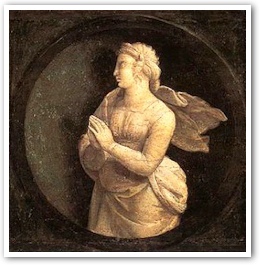The Second Coming
- FR. KENNETH BAKER, S.J.
After professing the Resurrection and Ascension of Jesus at the right hand of the Father, the Nicene Creed next affirms: He will come again in glory to judge the living and the dead, and his kingdom will have no end.
 |
Since there is much material here for fruitful reflective thought, we will take one truth at a time, beginning with the Christian belief that Jesus will come again.
Though not stressed much today, the idea of the Second Coming of Jesus occurs frequently in the New Testament. It is also called the "Day of the Lord" and the "Parousia", which means the "presence" or "arrival" of someone.
By the expression "the Second Coming", we are referring to the Christian belief in the words of Jesus that he will come again in glory to judge all men. The Parousia will signal the end of human history as we know it. When this will take place no one knows but the Father (Acts 1:11), nor is there any clear indication in Scripture of just how it will be accomplished.
In popular language we usually refer to these events as "the end of the world", which itself is not completely accurate, since the Day of the Lord does not mean that the universe as we know it will be annihilated, but only that it will be changed into something new and wonderful something that surpasses the imagination of man.
The New Testament gives some intimations of the signs that the Lord is about to come and judge the world. There is mention of wars, famines, earthquakes, upheavals in the planets and the stars. These "signs" are borrowed from the apocalyptic language of the Old Testament, especially as it is found in Daniel 7 and in the prophet Joel.
The Second or final Coming of Jesus in glory is contrasted with his first coming in humility as the Son of Mary and Joseph. So the Incarnation is spoken of his first appearance to mankind. Through his death-Resurrection-Ascension, Jesus passed from this life to a new and glorious life in heaven. From there he sends out the Holy Spirit on his Church. Now he is present in our midst through faith, through the preaching of the Gospel and in the sacraments.
In many places, the New Testament mentions the Parousia of the Lord. "They will see the Son of man coming on the clouds of heaven" (Mt 24:30); "If it is my will that he (John) remain until I come, what is that to you?" (Jn 21:23); "This Jesus will come in the same way as you saw him go into heaven" (Acts 1:11).
When Jesus comes again in glory, human history will be terminated. All will be transformed, both the living and the dead (see 1 Cor 15:51-56). Thus everything now is provisional. There was a current of thought among early Christians, reflected strongly in St. Paul's two letters to the Thessalonians, that the glorified Lord would come soon. This is to be understood as a hope and an expectation that the Lord would soon come and establish his definitive kingdom by destroying all of the powers of sin and evil. It was not a firm conviction or a certain judgement.
To the early Christians the Second Coming of Jesus, which was understood as the consummation of God's work in redeeming the human race, was not something to be feared. Rather, it was hoped for, longed for. They fervently prayed, "Come, Lord" (1 Cor 16:22). In fact, the next-to-last sentence of the entire Bible reflects this longing, first by quoting Jesus himself, and then by adding a prayer: "'Surely I am coming soon.' Amen. Come, Lord Jesus!" (Rev 22:20). As believing, hoping followers of Jesus Christ, this should also be our prayer.
See the index of chapters from Fundamentals of Catholicism which have been reprinted to CERC here.
 This is Meaghen Gonzalez, Editor of CERC. I hope you appreciated this piece. We curate these articles especially for believers like you.
This is Meaghen Gonzalez, Editor of CERC. I hope you appreciated this piece. We curate these articles especially for believers like you.
Please show your appreciation by making a $3 donation. CERC is entirely reader supported.

Acknowledgement
Kenneth Baker, S.J. "The Second Coming." In Fundamentals of Catholicism Vol. 1 Chapter 26 (San Francisco: Ignatius Press, 1995), 80-81.
This article reprinted with permission from Father Kenneth Baker, S.J.
The Author

 Father Kenneth Baker, S.J., assumed editorship of Homiletic & Pastoral Review in April 1971 and remained in this position for almost forty years. In 1983 he published a three-volume explanation of the faith called Fundamentals of Catholicism Vol. 1, Creed and Commandments; Vol. 2, God, Trinity, Creation, Christ, Mary; and Vol. 3, Grace, the Church, the Sacraments, Eschatology
Father Kenneth Baker, S.J., assumed editorship of Homiletic & Pastoral Review in April 1971 and remained in this position for almost forty years. In 1983 he published a three-volume explanation of the faith called Fundamentals of Catholicism Vol. 1, Creed and Commandments; Vol. 2, God, Trinity, Creation, Christ, Mary; and Vol. 3, Grace, the Church, the Sacraments, Eschatology




